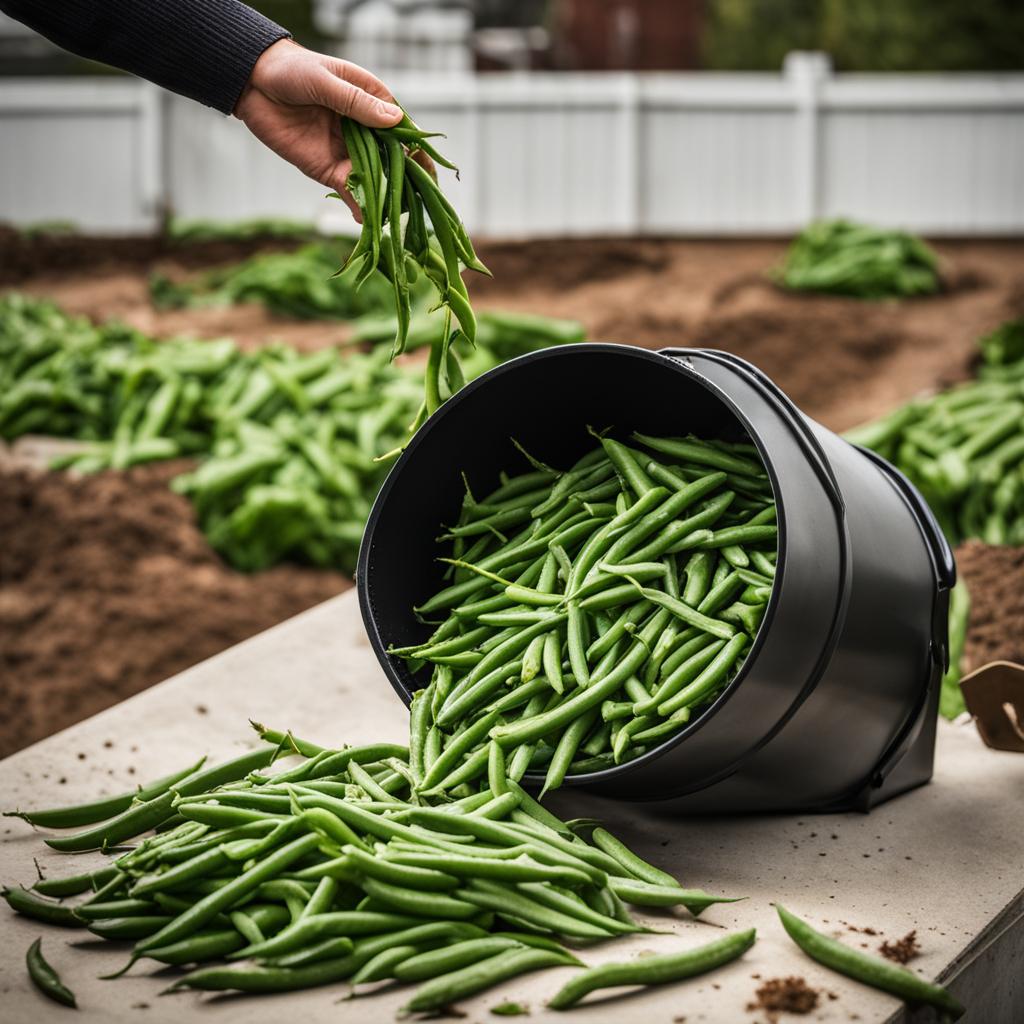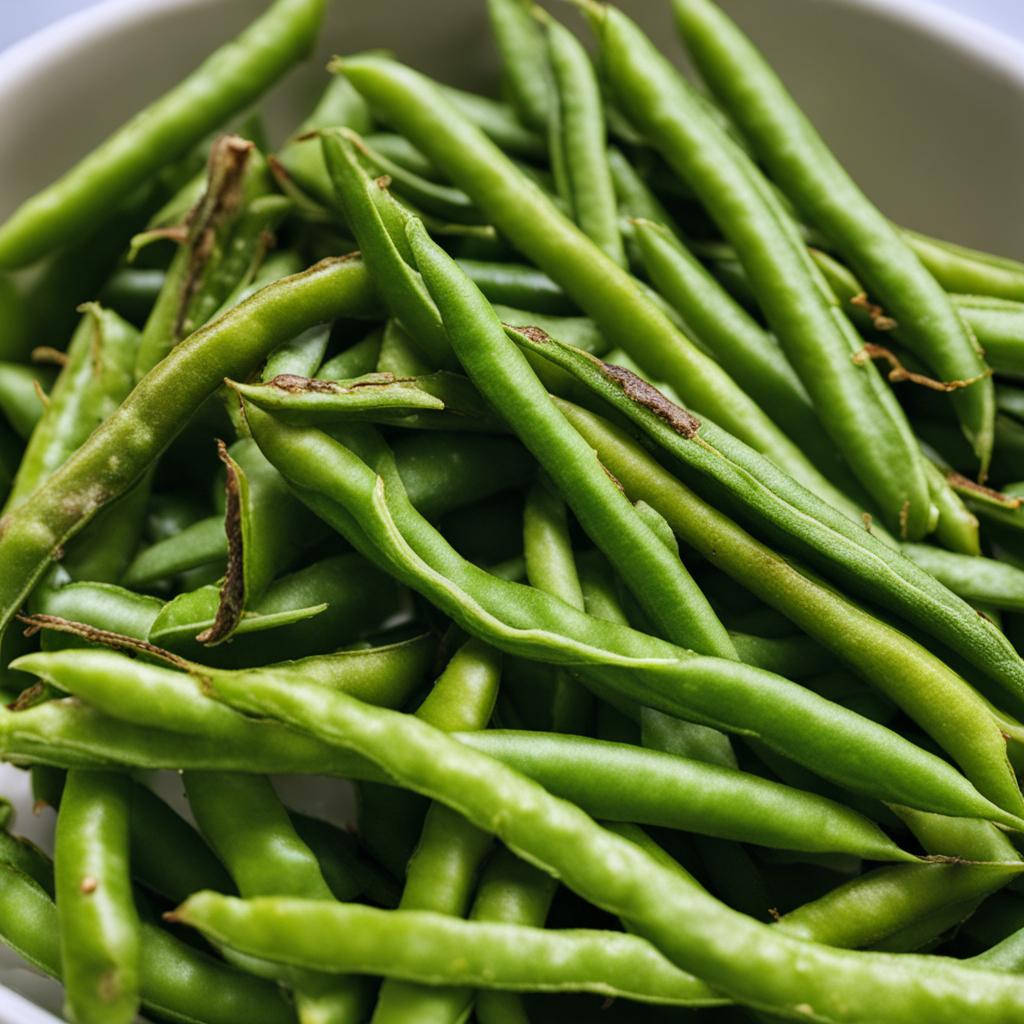Green beans are a popular vegetable known for their vibrant color and delicious flavor. However, like any perishable food, they can go bad over time. Knowing how to identify spoiled green beans is essential to ensure your dishes are safe and tasty. In this article, I will provide you with valuable tips on how to tell if green beans are bad, so you can enjoy their freshness and avoid any unpleasant surprises.
Key Takeaways:
- Green beans can spoil over time, but there are signs to watch out for.
- Spoilage indicators include a loss of vibrant green color, brown spots, fuzzy mold, and a slimy texture.
- Fresh green beans should feel firm, snap apart when bent, and have a pleasant smell.
- Proper storage in the refrigerator or freezing can help extend the shelf life of green beans.
- When in doubt, trust your senses and discard any green beans that look, smell, or feel off.
Signs of Bad Green Beans: Visual Cues
When it comes to determining whether green beans are bad or not, visual cues can provide valuable insights. By carefully examining the appearance of green beans, you can easily spot signs of spoilage and decide whether they are still safe to eat.
One of the first things to look for is the color of the beans. Fresh green beans should have a vibrant green hue, indicating their crispness and quality. If the beans have lost their brightness and appear dull or have developed brown spots, it could be a sign that they are past their prime and may not taste as fresh.
Texture is another key visual cue. When green beans are fresh, they should feel firm to the touch. However, if they have become limp or have a slimy texture, it is a clear indication that they have started to spoil. Additionally, the presence of fuzzy mold on the beans is a definite sign that they should be discarded immediately.
Visual cues play an important role in determining the freshness of green beans. By paying attention to their color, texture, and the presence of mold, you can confidently decide whether the beans are still good to use in your favorite recipes.
| Signs of Bad Green Beans: | Visual Cues |
|---|---|
| Color: | Loss of vibrant green, brown spots |
| Texture: | Limpness, sliminess |
| Mold: | Fuzzy growth |
Storing Green Beans for Freshness
Proper storage is key to maintaining the freshness of green beans. By storing them correctly, you can extend their shelf life and ensure they stay crisp and delicious for longer.
Refrigeration
The refrigerator is the best place to store green beans. Place them in a plastic bag or airtight container in the vegetable drawer to help maintain their freshness. The cool temperature of the fridge slows down the aging process and prevents spoilage.
Freezing
If you have an abundance of green beans and want to preserve them for future use, freezing is a great option. To freeze green beans, start by blanching them. Trim the stem ends, then blanch the beans in boiling water for a few minutes. Next, transfer them to an ice bath to cool them down quickly. Once the beans are cool, drain them well and store them in freezer bags. Frozen green beans can last up to 8 months in the freezer and are perfect for soups, stews, and stir-fries.
Shelf Life
When stored properly in the refrigerator, fresh green beans can last up to 5 days. It is important to check the beans regularly and discard any that show signs of spoilage, such as discoloration or a slimy texture.
By following these storage methods, you can enjoy the fresh and vibrant flavor of green beans for an extended period of time. Whether you choose to refrigerate them or freeze them for later use, proper storage is key to keeping green beans at their best.
| Storage Method | Shelf Life |
|---|---|
| Refrigeration | Up to 5 days |
| Freezing | Up to 8 months |
Nutritional Benefits of Green Beans
Green beans are not only delicious, but they also offer a wide range of nutritional benefits. These vibrant vegetables are packed with essential nutrients that support overall health and well-being.
One of the standout nutritional benefits of green beans is their high protein content. Protein is an important macronutrient that plays a key role in muscle development, tissue repair, and immune function. Incorporating green beans into your diet can help meet your daily protein needs.
In addition to protein, green beans are a great source of fiber. Fiber is essential for healthy digestion and can help regulate cholesterol levels. It also promotes feelings of fullness, making green beans a great addition to a balanced diet for weight management.
| Nutrient | Amount per Serving |
|---|---|
| Vitamin K | 15% of the Daily Value |
| Vitamin A | 10% of the Daily Value |
| Vitamin C | 8% of the Daily Value |
| Potassium | 6% of the Daily Value |
| Folate | 5% of the Daily Value |
Along with protein and fiber, green beans are rich in several vitamins and minerals. They are particularly high in vitamin K, vitamin A, and vitamin C. These vitamins have antioxidant properties, supporting immune function and overall health. Green beans also provide a good amount of folate and potassium, which are important for cardiovascular health and proper cell function.
Incorporating green beans into your meals is a simple way to boost your nutrient intake and add variety to your diet. Whether enjoyed steamed, sautéed, or roasted, green beans are a nutritious and versatile vegetable that can support your overall well-being.
Cooking Ideas for Green Beans
When it comes to cooking green beans, there are numerous culinary possibilities to explore. From the classic methods of steaming and boiling to more adventurous techniques like grilling and roasting, the versatility of green beans allows for a range of flavors and textures to be created. Whether you’re looking for a simple side dish or a vibrant addition to a salad, green beans offer a delicious and nutritious option.
One popular cooking method for green beans is steaming. This gentle cooking technique helps to preserve the vibrant color and crisp texture of the beans. Simply place the green beans in a steamer basket over boiling water and steam for 5-7 minutes, or until they are tender-crisp. This method is a great way to showcase the natural flavors of the beans and pairs well with a variety of seasonings and sauces.
If you’re looking to add a smoky and charred flavor to your green beans, grilling is an excellent choice. Toss the beans in olive oil, salt, and pepper, then place them on a preheated grill. Cook for 8-10 minutes, turning occasionally, until they are tender and have developed delicious grill marks. This method gives the beans a beautiful smoky flavor that pairs well with grilled meats or as a standalone side dish.
For those who prefer a richer and more intense flavor, roasting green beans is a great option. Spread the beans on a baking sheet, drizzle with olive oil, and season with your favorite herbs and spices. Roast in a preheated oven at 425°F for 15-20 minutes, or until they are slightly caramelized and tender. The roasting process helps to bring out the natural sweetness of the beans and creates a delightful depth of flavor.
Try this delicious recipe:
“Roasted Green Beans with Parmesan and Garlic”
- 1 pound of fresh green beans
- 2 tablespoons of olive oil
- 2 cloves of garlic, minced
- 1/4 cup of grated Parmesan cheese
- Salt and pepper to taste
- Preheat your oven to 425°F.
- Trim the ends of the green beans.
- In a large bowl, toss the green beans with olive oil, minced garlic, salt, and pepper.
- Spread the green beans in a single layer on a baking sheet.
- Sprinkle the grated Parmesan cheese over the green beans.
- Roast in the oven for 15-20 minutes, or until the green beans are tender and the cheese is golden and crispy.
- Serve hot and enjoy!
For those who enjoy the convenience and speed of cooking appliances, green beans can also be prepared in an air fryer. Toss the beans with a little bit of olive oil and your favorite seasonings, then cook them in the air fryer at 400°F for 8-10 minutes, shaking the basket halfway through. This method results in perfectly crispy green beans with a fraction of the cooking time.
With these cooking ideas, you can elevate the flavor of green beans and add variety to your meals. Whether you prefer the simplicity of steaming, the smoky taste of grilled beans, the rich flavors of roasted beans, or the quick and crispy results from an air fryer, there’s a cooking method to suit every palate.
How to Determine If Green Beans Are Bad
When it comes to determining the freshness of green beans, a visual inspection is key. Look out for signs of spoilage, such as discoloration, brown spots, or yellowing. Fresh green beans should have a vibrant green color, so any loss of brightness could indicate aging or spoilage.
Another important factor to consider is the texture of the beans. Fresh green beans should be firm, while older beans may feel limp or develop a slimy texture. If the beans appear mushy or have a slimy coating, it’s a clear indication that they are no longer suitable for consumption.
To further assess the freshness of green beans, rely on your sense of smell. Fresh green beans should have a slightly sweet and grassy scent. However, if you detect an unpleasant odor, it’s a strong indicator that the beans have gone bad.
“When it comes to determining if green beans are bad, trust your senses – if they look, smell, or feel off, it’s best to discard them.”
Remember, fresh green beans should be firm, crisp, and have a vibrant color. If they show signs of spoilage, such as discoloration, a slimy texture, or an unpleasant odor, it’s advised to dispose of them properly to avoid any potential food poisoning.
Disposing of Spoiled Green Beans
When green beans have gone bad, it’s important to dispose of them properly to prevent any potential health risks. There are two main methods for disposing of spoiled green beans: composting and throwing them away.
Composting
Composting is an environmentally-friendly way to dispose of spoiled green beans. Adding them to a compost bin or pile allows them to break down naturally and contribute valuable nutrients to the compost. Make sure to chop the green beans into smaller pieces before adding them to the compost, as this will help them decompose faster. Avoid adding any other items that may have come into contact with meat or dairy products, as these can attract pests or introduce harmful bacteria to the compost pile.
Throwing Away
If you don’t have a composting system or prefer not to compost your spoiled green beans, throwing them away is another option. However, it’s important to follow proper disposal guidelines to prevent odors and potential contamination. Wrap the spoiled green beans in a plastic bag and tie it securely to contain any odors. Dispose of the bag in an outdoor garbage bin, as this will help minimize any potential odors inside your home.
Remember, spoiled green beans should never be consumed, as they can cause food poisoning. Whether you choose to compost or throw them away, disposing of spoiled green beans properly is essential for maintaining a clean and healthy environment.

How to Store Green Beans Properly
When it comes to storing green beans, proper techniques can help maintain their freshness and flavor for longer. Here are some tips to ensure you store your green beans properly:
- Refrigeration: Green beans should be stored in the refrigerator to slow down the aging process and prevent spoilage. Keep them in the vegetable drawer where the temperature and humidity are suitable for preserving their quality.
- Perforated Plastic Bag: To maintain the optimal moisture levels, store your green beans in a perforated plastic bag. This allows for proper air circulation while preventing excessive moisture buildup that can lead to spoilage.
- Washing Before Use: It’s best to avoid washing green beans until you’re ready to use them. Excess moisture can accelerate the spoilage process, so wait until just before cooking to rinse them. This will help them stay fresh for longer.
By following these storage guidelines, you can extend the shelf life of your green beans and enjoy their freshness in your meals. Remember to check for any signs of spoilage before using them, and discard any beans that show discoloration, mold, or a slimy texture.
| Storage Method | Benefits | Drawbacks |
|---|---|---|
| Refrigeration | Preserves freshness and flavor | Requires refrigerator space |
| Perforated Plastic Bag | Maintains proper moisture levels | May require special storage bags |
| Washing Before Use | Prevents excess moisture buildup | Requires extra time before cooking |
Remember, fresh and properly stored green beans are the key to enjoying their vibrant color, crisp texture, and delicious taste in your recipes. Don’t let spoilage go to waste!
Problems with Green Beans: Brown Spots, Mold, Sliminess, Wrinkles
Green beans, like any other produce, can sometimes encounter issues that affect their quality and edibility. It’s important to be aware of the common problems that can arise with green beans to ensure you’re enjoying the best possible culinary experience. Here are some problems you may encounter:
Brown Spots
Brown spots on green beans are often an aesthetic concern rather than a sign of spoilage. These spots can occur due to natural aging or exposure to air. In most cases, brown spots are harmless and can be trimmed or ignored when preparing the beans. However, if the spots appear excessive or have an unusual texture, it’s best to discard the affected beans.
Mold
Mold growth on green beans is a clear indication of spoilage and should not be overlooked. Mold can appear as fuzzy spots or patches of discoloration. Consuming moldy green beans can lead to food poisoning and should be avoided. Discard any green beans with mold and thoroughly clean the area where they were stored to prevent further contamination.
Sliminess
While green beans naturally have a slightly slimy texture when cooked, excessive sliminess can be a sign of deterioration. If the beans feel excessively sticky or produce a slimy residue when handled, they may be past their prime. However, a light rinse and close inspection for any off-putting odors can help determine if they are still usable.
Wrinkles
Wrinkled green beans are often a result of dehydration or extended storage. While these beans may not have the best texture, they can still be cooked and consumed without causing any harm. Blanching wrinkled green beans before cooking can help rehydrate them and improve their overall appearance and texture.
By being aware of these common problems with green beans, you can make informed decisions when selecting, storing, and preparing them. Remember to trust your senses and prioritize food safety to ensure a delightful culinary experience every time.

How to Store Green Beans and Extend Their Freshness
Proper storage is essential to keep green beans fresh and extend their shelf life. By following these tips, you can prevent premature spoilage and enjoy crisp and flavorful green beans for longer.
Storing Green Beans
When storing green beans, it’s important to avoid tightly sealing them in a plastic bag, as this can lead to condensation and mold growth. Instead, opt for a reusable container with a lid or a breathable mesh produce bag. These options allow for proper air circulation, helping to maintain the freshness of the beans.
Another key factor in storing green beans is to keep them refrigerated. The cool temperature of the refrigerator helps slow down the aging process and keeps the beans crisp. Remember to refrain from washing the beans until you’re ready to use them, as excess moisture can promote spoilage.
Extending Freshness
If you want to extend the freshness of your green beans even further, consider blanching and freezing them. Blanching involves boiling the beans for a short period of time, followed by quickly cooling them in an ice bath. This process helps preserve the color, texture, and nutritional value of the beans. Once blanched, store the beans in freezer bags or airtight containers and place them in the freezer. Frozen green beans can retain their quality for up to 8 months.
By following these storage and preservation methods, you can maximize the shelf life of your green beans, reducing waste and ensuring that you always have a supply of fresh and tasty beans on hand.
| Storage Tips | Benefits |
|---|---|
| Use a reusable container or mesh produce bag | Allows for proper air circulation to prevent mold |
| Store green beans in the refrigerator | Slows down the aging process |
| Avoid washing green beans until ready to use | Prevents excess moisture and promotes freshness |
| Blanch and freeze green beans | Preserves color, texture, and nutrition for long-term storage |
How Long Do Fresh Green Beans Last?
When it comes to the shelf life of fresh green beans, it’s important to consider their source. Green beans purchased from a grocery store typically have a shorter lifespan compared to those obtained from a garden or farmer’s market.
If you’ve bought green beans from a grocery store, it’s advisable to consume them within 3 days of purchase. This ensures that you enjoy their optimal freshness and flavor. However, if you have green beans sourced directly from a garden or farmer’s market, they can last up to a week or even longer if stored correctly.
To maximize the freshness of your green beans, proper storage is key. Keep them in the refrigerator to maintain their quality for a longer period. It’s also important to avoid excessive moisture, as it can accelerate spoilage. By refrigerating your green beans and preventing them from getting damp, you can extend their shelf life and enjoy them for a longer time.
| Source | Shelf Life |
|---|---|
| Grocery Store | Up to 3 days |
| Garden or Farmer’s Market | Up to a week or longer |
Remember, freshness is crucial when it comes to enjoying the best taste and nutritional value from your green beans. So, whether you prefer to buy them from a grocery store or directly from the source, proper storage and timely consumption will ensure that your green beans stay delicious and nutritious.
How Long Do Cooked Green Beans Last?
When it comes to storing cooked green beans, it’s important to follow proper food safety guidelines to ensure their freshness and prevent the risk of foodborne illness. Cooked green beans can be refrigerated and should be consumed within 3 days. It is crucial to cool the beans before refrigeration to avoid bacterial growth.
The general rule for leftovers is to eat them within 3 days, and the same applies to cooked green beans. By following this guideline, you can enjoy the taste and nutritional benefits of your cooked green beans while minimizing any potential health risks. Remember to store them in airtight containers or covered in the refrigerator to maintain their quality.
To avoid any confusion or accidental consumption of spoiled cooked green beans, it’s helpful to label the containers with the date they were cooked. This way, you can easily keep track of how long they have been stored and know when it’s time to discard them.
Proper Storage Guidelines for Cooked Green Beans:
- Cool the cooked green beans before refrigeration to prevent bacterial growth.
- Store them in airtight containers or covered to maintain freshness.
- Label the containers with the date of cooking for easy tracking.
- Consume within 3 days to ensure food safety.
By following these storage guidelines and consuming your cooked green beans within the recommended timeframe, you can enjoy their delicious taste and nutritional benefits while maintaining food safety.
Conclusion
In conclusion, green beans are a fantastic addition to any diet, providing a range of nutritional benefits and culinary possibilities. However, it’s important to be mindful of their freshness and take proper storage precautions to avoid spoilage.
By conducting a visual inspection and relying on your senses, you can easily determine if green beans have gone bad. Signs of spoilage include discoloration, mold growth, sliminess, and wrinkles.
To ensure the freshness of green beans, store them in the refrigerator in a perforated plastic bag or a breathable produce bag. Avoid washing them until you’re ready to use them, as excess moisture can lead to spoilage. Following these storage guidelines will help you enjoy crisp, flavorful green beans for longer.
Remember, maintaining the freshness of green beans not only ensures their quality but also maximizes their nutritional value. So, be mindful of proper storage and handling, and savor the goodness of green beans in your meals.
FAQ
How can I tell if green beans are bad?
Signs of spoilage include a loss of vibrant green color, brown spots, fuzzy mold, and a slimy texture. Fresh green beans should feel firm and snap apart when bent. Some varieties may have an “off smell” when they’ve gone bad.
What are some visual cues that indicate green beans are bad?
Fresh green beans should be a vibrant green color; if they have lost their brightness or have brown spots, they may be aging. The texture of fresh green beans should be firm, while older beans may feel limp and develop a slimy texture. Fuzzy mold is a clear indication that green beans are too bad to eat.
How should I store green beans to maintain their freshness?
Green beans can be stored in a plastic bag or airtight container in the vegetable drawer of the refrigerator. Green beans can also be blanched and frozen for later use.
What are the nutritional benefits of green beans?
Green beans are a good source of protein, fiber, folate, potassium, and vitamins K, A, and C. They offer benefits for digestion, maintaining a healthy weight, and heart health.
What are some cooking ideas for green beans?
Green beans can be steamed, grilled with pesto, roasted in olive oil, or cooked in an air fryer for a crispy texture. They can be used in casseroles, side dishes, and salads.
How can I determine if green beans are bad?
Conduct a visual inspection for signs of discoloration, such as brown spots or yellowing. Mold, an unpleasant odor, and a slimy or mushy texture are indications of spoilage. Trust your senses – if the beans look, smell, or feel off, it’s best to discard them.
How should I dispose of spoiled green beans?
One option is to compost them by adding them to a compost bin or pile. Another option is to throw them away, but be sure to wrap them in a plastic bag and dispose of them in an outdoor bin to prevent odors.
How should I store green beans properly?
Store them in the refrigerator in a perforated plastic bag or a breathable produce bag. Avoid washing the beans until you’re ready to use them, as excess moisture can lead to spoilage.
What are some problems that can occur with green beans?
Brown spots, mold growth, sliminess, and wrinkles can occur with green beans. Brown spots may be tolerated if not too severe, while any mold growth is a definite sign of spoilage. Wrinkled beans may not have the best texture but can still be cooked and consumed.
How can I store green beans to extend their freshness?
Avoid tightly storing them in the plastic bag from the grocery store. Instead, use a reusable container with a lid or a breathable mesh produce bag. Keep the beans in the refrigerator and refrain from washing them until ready to use.
How long do fresh green beans last?
Those from the grocery store should be consumed within 3 days, while garden or farmer’s market green beans can last up to a week or more with proper storage.
How long do cooked green beans last?
Cooked green beans should be consumed within 3 days if properly stored in the refrigerator. It is important to cool cooked green beans and other leftovers before refrigeration.
What are some concluding thoughts on green beans and freshness?
Green beans are a versatile and nutritious vegetable, but they can spoil if not stored or handled properly. Checking for signs of spoilage, proper storage, and using your senses can ensure the safety and quality of your green beans.
Source Links
- https://ginabnutrition.com/veganism/how-to-tell-if-green-beans-are-bad-a-simple-guide/
- https://www.eatlikenoone.com/how-to-tell-if-green-beans-are-bad.htm
- https://jennabraddock.com/how-to-tell-if-green-beans-are-too-bad-to-eat/
Related Recipes:
 How to Tell if Cauliflower is Past Its Prime
How to Tell if Cauliflower is Past Its Prime
 Spotting Bad Lemons: What to Look For
Spotting Bad Lemons: What to Look For
 How to Tell if Jelly Has Gone Bad: Preserving Quality
How to Tell if Jelly Has Gone Bad: Preserving Quality
 How to Tell if Cheese is Bad: A Comprehensive Guide
How to Tell if Cheese is Bad: A Comprehensive Guide
 Spotting Bad Butternut Squash
Spotting Bad Butternut Squash
 How to Store Fish to Ensure Freshness
How to Store Fish to Ensure Freshness
 How to Identify a Bad Onion
How to Identify a Bad Onion
 Recognizing When a Tomato is Past Its Prime
Recognizing When a Tomato is Past Its Prime








